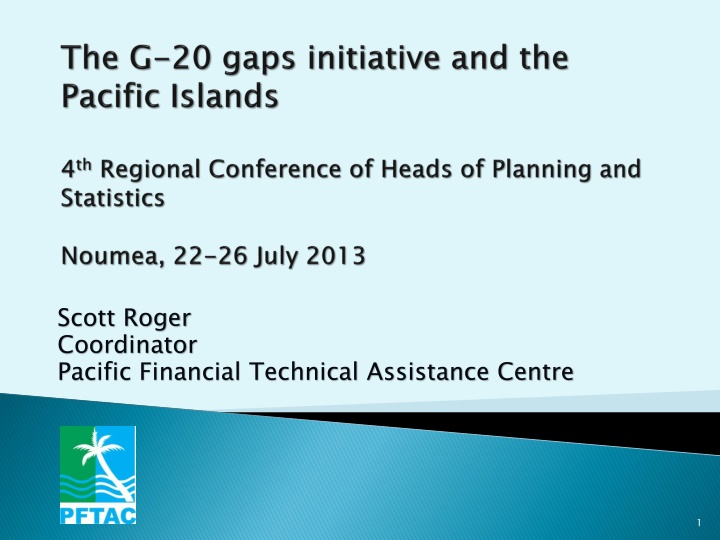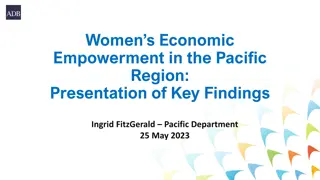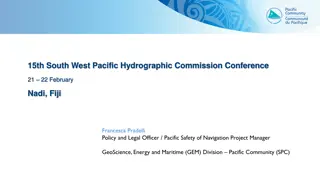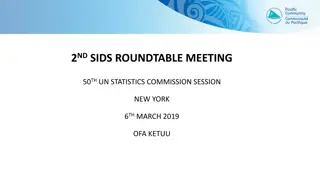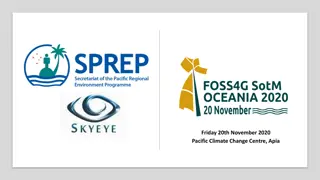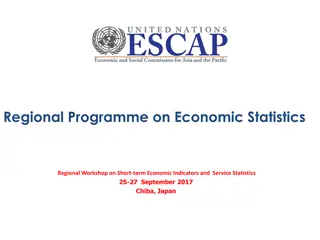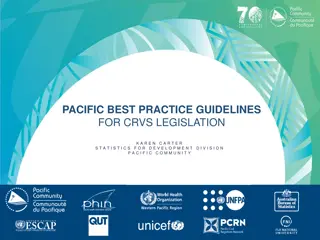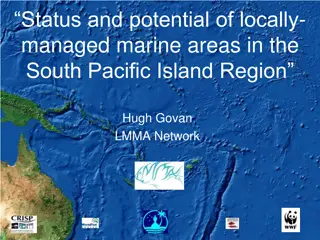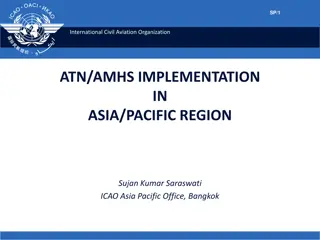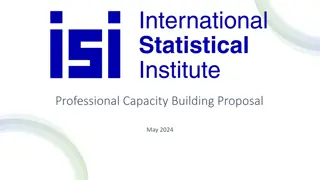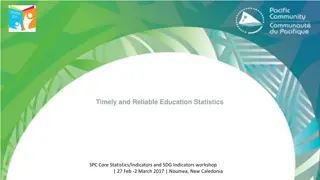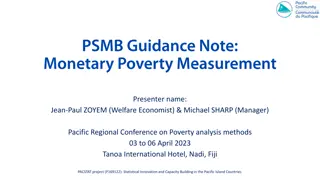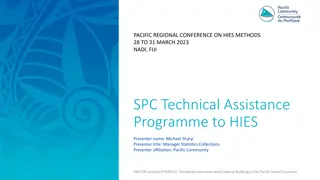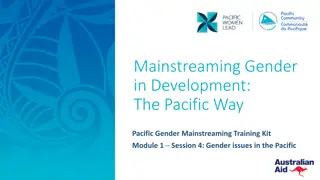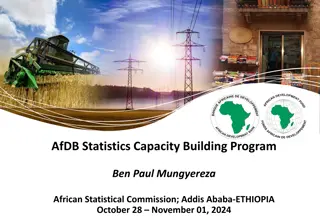Enhancing Economic Statistics for Pacific Region
Providing insights into the G-20 Gaps Initiative and its implications for Pacific Island states. Learn about the importance of economic statistics in policy-making and the role of organizations like PFTAC in fostering economic prosperity.
Download Presentation

Please find below an Image/Link to download the presentation.
The content on the website is provided AS IS for your information and personal use only. It may not be sold, licensed, or shared on other websites without obtaining consent from the author.If you encounter any issues during the download, it is possible that the publisher has removed the file from their server.
You are allowed to download the files provided on this website for personal or commercial use, subject to the condition that they are used lawfully. All files are the property of their respective owners.
The content on the website is provided AS IS for your information and personal use only. It may not be sold, licensed, or shared on other websites without obtaining consent from the author.
E N D
Presentation Transcript
Scott Roger Coordinator Pacific Financial Technical Assistance Centre 1
The business of PFTAC is to help provide governments in Pacific Island states with the tools they need to make good economic policies. Good economic statistics are essential to good economic policy decision-making, so developing and providing these is essential to the prosperity of the region. This presentation focuses on one area of economic statistics the G-20 gaps initiative because it is important and is setting new standards for data collection and dissemination that are bound to affect the whole region. 2
The G-20 gaps initiative: background Elements of the initiative Current status Implications for Pacific Islands 3
Global financial crisis showed that: Financial crises can be enormously costly in terms of output and employment, and can spread far beyond the origin of the crisis; Governments had quite limited information on the buildup of financial risks and channels of contagion between institutions, economic sectors, and countries; The lack of information impeded accurate assessment of risks and vulnerabilities, leading to inadequate policy measures before the crisis. It also contributed to the contagion of the crisis and is still hampering economic recovery. 4
In 2009, the G-20 asked IMF/FSB to assess key information gaps and needs. Four main interrelated areas for action were identified: Better assessment of the build-up and location of risks in the bank and non-bank financial sectors; Improvement in monitoring of cross-border bank exposures and capital flows and financial networks; Better assessment of the vulnerability of economies to financial shocks; Improvement of communication and dissemination of official statistics. 5
Recommendations to address these needs were the basis for an action plan known as the G-20 gaps initiative. The IMF s Statistics Department is working with the Inter-Agency Group on Economic and Financial Statistics (IAG) to coordinate this work.1 IMF/Financial Stability Board report to G-20 meetings. Next is due in Sept. 2013. Reports are posted on IMF and FSB websites. 1Established in 2008, the IAG is chaired by the IMF and consists of the Bank for International Settlements (BIS), the European Central Bank (ECB), Eurostat, the Organization for Economic Cooperation and Development (OECD), the United Nations, and the World Bank. 6
Improve coverage of indicators of financial health and soundness of financial institutions, the so-called Financial Soundness Indicators. Develop measures of aggregate leverage and maturity mismatches in the financial system. Improve information on financial markets and instruments: coverage of credit default swaps, not least to improve understanding of risk transfers within this market. disclosure requirements for complex structured products (IOSCO), and availability of standardized data on securities. 7
Better understand cross-border financial linkages of systematically important global financial institutions. Strengthen data collection on cross-border banking flows and positions: Coordinated Portfolio Investment Survey, BIS International Banking Statistics, and IIP data. monitoring and measuring cross-border exposures of nonfinancial, and financial corporations international exposures of nonbank financial institutions. Strengthen sectoral coverage of national balance sheets, flow of funds, and sectoral data more generally (and distributional information). 8
Promote timely and cross-country standardized and comparable government finance statistics. Disseminate more comparable data on real estate prices. Improve the communication of official statistics and close gaps in availability of data to users. Making data more accessible and timely for a wider audience through the Principal Global Indicators site. Recommendations take two forms: Enhancing existing statistical frameworks, collection, and dissemination; Developing new frameworks and data sources and methods. 9
Enhance existing Statistical Frameworks and Ongoing Collection New Conceptual or Statistical Frameworks to be developed Elements of the G-20 data gaps initiative # 2 Financial Soundness Indicators (FSIs) #5 Credit Default Swaps #7 Securities # 3 Tail Risk in the Financial System #4 Aggregate Leverage and Maturity Mismatches; #6 Structured Products Build-up of Risk in the Financial Sector # 10, #11, #12 Coordinated Portfolio Investment Survey, International Banking Statistics, International Investment Positions #8 and # 9 Global Network Connections and Systemically Important Global Institutions # 13 and #14 Financial and Nonfinancial Corporations Cross Border Exposures Cross-border Financial Linkages #15 Institutional Sector Accounts # 17 Government Finance Statistics # 18 Public Sector Debt #19 Real Estate Prices Vulnerability of Domestic Economies to Shocks #16 Distributional Information #20 Principal Global Indicators (PGIs) Improving Communication of Official Statistics 6
Significant progress has been made in most areas: For areas where there are existing statistical frameworks, real progress in improving coverage, timeliness, comparability & dissemination. In general, target dates for full implementation by 2014. For areas where frameworks need development, progress is less visible, but cooperation among agencies is good and pilot exercises are under way in several areas. More information: http://www.imf.org/external/np/g20/pdf/093012.pdf 11
The gaps initiative is aimed first and foremost at advanced economies with large, complex financial systems. But several of the areas covered are also relevant in the Pacific region: Development and dissemination of financial soundness and macroprudential risk indicators; Cross-border flows and exposures for banks and non- banks, and international investment positions; Standardization of government financial statistics, and development of public sector debt statistics; Development of real estate price statistics. 13
In some cases, higher standards will have a direct impact on Pacific states through SDDS requirements. More generally, countries will come under pressure to conform to the higher standards of data comprehensiveness, timeliness, and dissemination from market participants (ratings agencies, investors, banks). Statistical agencies, central banks, and finance ministries in the Pacific need to recognize and prepare for adoption of these higher standards. Merci/Thank you Merci/Thank you 14
